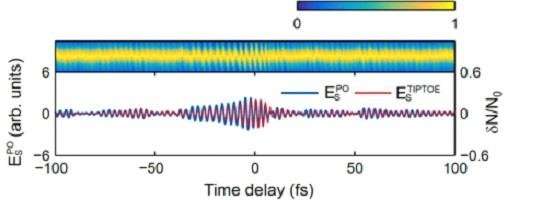Schematic diagram of TIPTOE technology.Special mirrors divide a laser beam into a strong (EF) and a weak (ES) laser pulses. When the laser beams reach the air or gas-filled chamber, electrons escape from their atoms (tunnel ionization) and are caught by the metal plates. Changes in ionization are used to measure the shape of the laser pulse. Credit: Institute for Basic Science
A team of researchers at the Center for Relativistic Laser Science, within the Institute for Basic Science (IBS) have developed a method to measure the shape of laser pulses in ambient air. Unlike conventional strategies, it is does not require a vacuum environment and can be applied to laser beams of different wavelengths (UV, visible or longer). This patented technique, currently available for technology transfer and commercialization, has now been published in Optica, and it is expected to accelerate studies on light-matter interaction.
Experts aim to employ laser light to control the behavior of the electrons, and potentially to manipulate electric currents. However, in order to reach these goals, it is essential to know the waveform of a laser pulse. As molecular events occur in just attoseconds (1 as = 10-18 seconds), the existing method to study them relies on the generation of attosecond X-ray pulses which requires detection equipment in vacuum chambers. IBS researchers devised an alternative approach called TIPTOE (tunneling ionization with a perturbation for the time-domain observation of an electric field) which needs neither X-rays pulses nor vacuum conditions.
TIPTOE is based on two superimposed laser pulses: a strong one and a weak one. Atoms or molecules exposed to intensive electric fields, like the ones created by strong laser pulses, can lose some of their electrons in a phenomenon called tunnel ionization. The TIPTOE method depends on the intensity of the electric field and the tunnel ionization of the electrons of the atoms in the air. Time differences between the strong and the weak superimposed laser pulses cause the electric field intensity to vary. As a higher electric field intensity corresponds to higher ionization, changes in the electric field are directly reflected on the tunnel ionization. And in turn, these changes in tunnel ionization are used to measure the shape of the laser pulse. Since tunneling ionization lasts only 200 attoseconds, the TIPTOE method can provide enough temporal resolution to measure UV, visible, and longer wavelength pules.
Comparison between attosecond X-ray pulse method X-ray (blue) and TIPTOE (red) to validate the new technique developed by IBS scientists. The waveforms measured with TIPTOE match the ones obtained with the conventional method. Credit: Institute for Basic Science
IBS scientists validated TIPTOE by comparing it with the conventional X-ray pulse generation technique, and the results were the same.
"TIPTOE's biggest advantage is the universality of this technique at different wavelengths," explains Kyung Taec Kim, the leading author of this study.
More information: Seung Beom Park et al. Direct sampling of a light wave in air, Optica (2018). DOI: 10.1364/OPTICA.5.000402 Seung Beom Park et al. Direct sampling of a light wave in air, Optica (2018). DOI: 10.1364/OPTICA.5.000402
Journal information: Optica
Provided by Institute for Basic Science

























